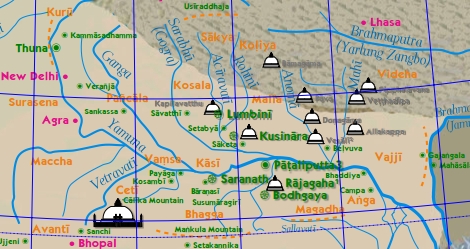




Jambudīpa

One of the four great continents (mahādīpa), which are included in the Cakkavāḷa and are ruled by a Cakkavatti. They are grouped round Mount Sineru. In Jambudīpa is Himavā with its eighty-
Sometimes in Jambudīpa there are as many as eighty-
At the time of Metteyya Buddh’as appearance on earth Jambudīpa will be pervaded by mankind even as a jungle is by reeds and rushes. There will be eighty-
The Buddha once declared that the people of Jambudīpa excel those of both Uttarakuru and Tāvatiṃsa in three respects — courage, mindfulness and religious life.⁹ Buddhas (and Cakkavattis) are born only in Jambudīpa.¹⁰
There were four sounds heard throughout Jambudīpa:
- the shout uttered by Punnaka proclaiming his victory over Dhanañjaya Koravya in a game of dice;
- the bark of Vissakamma when taken about in the guise of a dog by Sakka, threatening to devour all wicked beings after the decay of Kassapa’s sāsana;
- the roar of Kusa, challenging to battle the seven kings who sought the hand of Pabhāvatī;
- the yell of Āḷavaka, proclaiming his name from the top of mount Kelāsa, on hearing that the Buddha had visited his abode.¹¹
When opposed to Sīhaladīpa or Tambapaṇṇidīpa, Jambudīpa indicates the continent of India.¹²
For the purposes of wandering on tour (cārikā), the monks divided their tours in Jambudīpa into three circuits or maṇḍalas — the Mahāmaṇḍala which extended over nine hundred leagues, the Majjhima which extended over six hundred, and the Antima over three hundred. Those who wish to tour the first, start after the mahāpavāraṇa and complete their journey in nine months, for the Majjhimamaṇḍala they start after the Pavāraṇa, on the full-
In each Cakkavāḷa there is a Jambudīpa.¹⁴ Mention is made in the Kākavatī Jātaka¹⁵ of a Jambudīpa-
Footnotes
¹ Vin.i.30; SNA.ii.443; Vism.i.205 f; Sp.i.119, etc. ² SN.vs.552; SNA.i.121.
³ A league (yojana) is a day’s journey, and is estimated to be between eight and twelve miles. Clearly, the continent of India is not 10,000 leagues, or about 100,000 miles in extent (ed).
⁴ SNA.ii.437; UdA.300. ⁵ SNA.i.59; J.iv.84 says sixty-
⁶ Mhv.v.176; Vism.201. ⁷ A.i.35. ⁸ D.iii.75. ⁹ A.iv.396; Kvu.99.
¹⁰ BuA.48; MA.ii.917. ¹¹ SA.i.248, etc.
¹² E.g., Mhv.v.13; xiv.8; Cv.xxxvii.216, 246. ¹³ Sp.i.197. ¹⁴ A.i.227.
¹⁵ J.iii.91.

